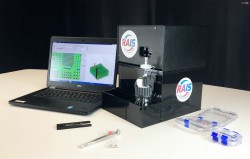Portable device detects sepsis in half an hour
Sepsis is a pathological condition characterised by the inadequate inflammatory response to an infection, possibly leading to organ dysfunction. This disease can be caused by microorganisms, such as bacteria or fungi, and its management basically focuses on how the infection is regulated through source control and antibiotics. The social and economic costs of sepsis are high with approximately 20 000 deaths occurring daily worldwide. In 2008, more than EUR 10 billion was spent on hospitalisation for sepsis in Europe and the United States. The RAIS project has developed a new point-of-care, label-free microarray platform for quantifying levels of sepsis-specific biomarkers within half an hour. Based on a proprietary interferometric, lens-free microscope design, the researchers successfully validated this system. “We wanted to develop a high throughput, rapid and sensitive device to detect sepsis at a low cost,” says Dr Pruneri, RAIS project coordinator. Complete overhaul for test design Current diagnostic protocols include blood tests, measurement of blood cell counts, serum lactate, and blood cultures for aerobic and anaerobic microorganisms. However, culture-based diagnosis is slow, and major efforts have been made to find biomarkers that allow early diagnosis of this disease. The RAIS project has developed an optical microarray reader that uses specific biomarkers for the detection of sepsis. This includes proteins involved in inflammation and commonly encountered bacteria taken from the blood samples of patients. The antibodies specific to these biomarkers were deposited and fixed on the microarray plate. The device contains a disposable cartridge integrated in a portable label-free microarray platform, which could potentially measure more than 1 million target samples at the same time. This has resulted in the development of an alpha prototype instrument that has been used for initial experiments. The team has further optimised the device with the development of a beta prototype reader that requires less sample volume for analysis and can be manufactured at a significantly lower cost. Furthermore, an automated post-processing software and graphical user interface have been included to reduce measurement processes and analysis by the commercial partners of the project. A commercial device based on the beta prototype could potentially provide results at a cost as low as EUR 50 per patient. “We had to increase the detection sensitivity of the optical reader using a nanostructured substrate, which resulted in the detection and quantification of the sepsis biomarkers CRP, E. coli and the small molecular weight protein PCT,” says Dr Pruneri. C reactive protein (CRP) is a commonly used biomarker for inflammation and PCT stands for procalcitonin – both are commonly found in blood plasma of sepsis patients. RAIS in the biotech industry In addition to development of the device, RAIS researchers have validated the microarray reader using samples from sepsis patients and generated a sepsis biobank composed of samples from both control and sepsis subjects. The results of RAIS R&D’s activities will complement the further development of this project. “We have already designed a new device, where the reading electronic card and software are incorporated. This will be part of the future product that will allow data analysis in the absence of a computer,” adds Dr Pruneri. “Exploitation of the technical development will continue with the commercial partner ThermoFisher and other companies with a view of further improving this technology and taking it forward to clinical trials,” continues Dr Pruneri. As well as detecting autoimmune conditions, this should facilitate the entry of new diagnostic kits in the serology market with applications for other diseases.
Keywords
RAIS, sepsis, microarray, diagnostic, biomarker, optical reader







